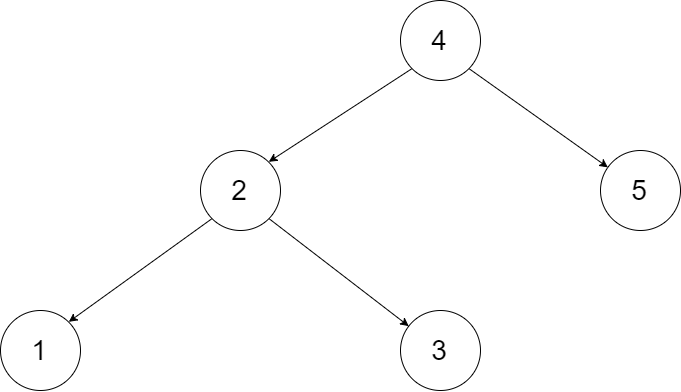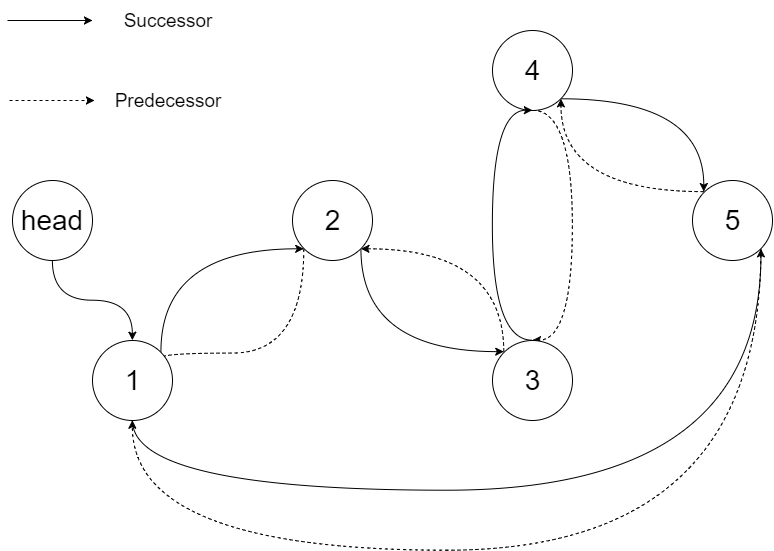【LeetCode】426. Convert Binary Search Tree to Sorted Doubly Linked List 解题报告 (C++)
- 作者: 负雪明烛
- id: fuxuemingzhu
- 个人博客:http://fuxuemingzhu.cn/
题目地址:https://leetcode-cn.com/problems/convert-binary-search-tree-to-sorted-doubly-linked-list/
题目描述
Convert a BST to a sorted circular doubly-linked list in-place. Think of the left and right pointers as synonymous to the previous and next pointers in a doubly-linked list.
Let’s take the following BST as an example, it may help you understand the problem better:

We want to transform this BST into a circular doubly linked list. Each node in a doubly linked list has a predecessor and successor. For a circular doubly linked list, the predecessor of the first element is the last element, and the successor of the last element is the first element.
The figure below shows the circular doubly linked list for the BST above. The “head” symbol means the node it points to is the smallest element of the linked list.

Specifically, we want to do the transformation in place. After the transformation, the left pointer of the tree node should point to its predecessor, and the right pointer should point to its successor. We should return the pointer to the first element of the linked list.
The figure below shows the transformed BST. The solid line indicates the successor relationship, while the dashed line means the predecessor relationship.

题目大意
将一个BST转换为有序的双向链表,并返回该双向链表的头指针。
解题方法
递归
看到BST就想到中序遍历是有序的。
中序遍历有两种做法:递归和迭代。递归的方式做法比较常见。
这里相对于普通的中序遍历的修改是对当前节点进行判断,如果有pre的话需要修改pre和当前node的指针。head节点的定义是左下角节点,也是真正处理的第一个节点。last节点是最后的一个节点。
当递归结束之后,需要把head和last拼接到一起。
C++代码如下:
/*
// Definition for a Node.
class Node {
public:
int val;
Node* left;
Node* right;
Node() {}
Node(int _val, Node* _left, Node* _right) {
val = _val;
left = _left;
right = _right;
}
};
*/
class Solution {
public:
Node* treeToDoublyList(Node* root) {
if (!root) return nullptr;
Node* head = nullptr;
Node* pre = nullptr;
Node* last = nullptr;
inorder(root, head, pre, last);
last->right = head;
head->left = last;
return head;
}
void inorder(Node* node, Node* &head, Node* &pre, Node* &last) {
if (!node) return;
inorder(node->left, head, pre, last);
if (pre) {
pre->right = node;
node->left = pre;
}
pre = node;
if (!head)
head = node;
last = node;
inorder(node->right, head, pre, last);
}
};
迭代
迭代的方法是通过一个栈来实现的,先把最左下角的节点放入栈中,然后依次出栈,出栈的时候处理该栈,并且把这个节点的右节点放入栈中。
C++代码如下:
/*
// Definition for a Node.
class Node {
public:
int val;
Node* left;
Node* right;
Node() {}
Node(int _val, Node* _left, Node* _right) {
val = _val;
left = _left;
right = _right;
}
};
*/
class Solution {
public:
Node* treeToDoublyList(Node* root) {
if (!root) return nullptr;
Node* head = nullptr;
Node* pre = nullptr;
Node* last = nullptr;
stack<Node*> st;
Node* p = root;
while (!st.empty() || p) {
if (p) {
st.push(p);
p = p->left;
} else {
Node* node = st.top(); st.pop();
if (!node) continue;
p = node->right;
if (!head)
head = node;
if (pre) {
pre->right = node;
node->left = pre;
}
pre = node;
last = node;
}
}
last->right = head;
head->left = last;
return head;
}
};
相似题目:94. Binary Tree Inorder Traversal
参考资料:https://leetcode-cn.com/problems/convert-binary-search-tree-to-sorted-doubly-linked-list/solution/liang-chong-jie-fa-by-jason-2-11/
日期
2019 年 9 月 21 日 —— 莫生气,我若气病谁如意
【LeetCode】426. Convert Binary Search Tree to Sorted Doubly Linked List 解题报告 (C++)的更多相关文章
- LeetCode 426. Convert Binary Search Tree to Sorted Doubly Linked List
原题链接在这里:https://leetcode.com/problems/convert-binary-search-tree-to-sorted-doubly-linked-list/ 题目: C ...
- [leetcode]426. Convert Binary Search Tree to Sorted Doubly Linked List二叉搜索树转有序双向链表
Convert a BST to a sorted circular doubly-linked list in-place. Think of the left and right pointers ...
- 426. Convert Binary Search Tree to Sorted Doubly Linked List把bst变成双向链表
[抄题]: Convert a BST to a sorted circular doubly-linked list in-place. Think of the left and right po ...
- [LC] 426. Convert Binary Search Tree to Sorted Doubly Linked List
Convert a BST to a sorted circular doubly-linked list in-place. Think of the left and right pointers ...
- [LeetCode] Convert Binary Search Tree to Sorted Doubly Linked List 将二叉搜索树转为有序双向链表
Convert a BST to a sorted circular doubly-linked list in-place. Think of the left and right pointers ...
- LeetCode426.Convert Binary Search Tree to Sorted Doubly Linked List
题目 Convert a BST to a sorted circular doubly-linked list in-place. Think of the left and right point ...
- [LeetCode] 272. Closest Binary Search Tree Value II 最近的二叉搜索树的值 II
Given a non-empty binary search tree and a target value, find k values in the BST that are closest t ...
- 【LeetCode】430. Flatten a Multilevel Doubly Linked List 解题报告(Python)
[LeetCode]430. Flatten a Multilevel Doubly Linked List 解题报告(Python) 标签(空格分隔): LeetCode 作者: 负雪明烛 id: ...
- [LeetCode#272] Closest Binary Search Tree Value II
Problem: Given a non-empty binary search tree and a target value, find k values in the BST that are ...
随机推荐
- 【6】蛋白质组学鉴定定量软件之MaxQuant
目录 1.简介 2.下载安装 3.配置与运行 4.结果 5.Perseus后处理 6.小结 1.简介 2016年,德国马普所的Cox和蛋白质组学领域巨擘Matthias Mann合作开发了MaxQua ...
- python写的多项式符号乘法
D:\>poly.py(x - 1) * (x^2 + x + 1) = x^3 - 1 1 import ply.lex as lex # pip install ply 2 import p ...
- HDFS【hadoop3.1.3 windows开发环境搭建】
目录 一.配置hadoop3.1.3 windows环境依赖 配置环境变量 添加到path路径 在cmd中测试 二.idea中的配置 创建工程/模块 添加pom.xml依赖 日志添加--配置log4j ...
- 零基础学习java------day8------javabean编写规范,继承,static关键字,代码块,单例设计模式
0. 今日内容提要 1. javabean书写规范 javabean:一个普通的类,用来描述事物的类,里面不包含任何的业务逻辑,只是用来存储数据. 比如:Teacher,Student,Mobile. ...
- How exactly does Google AdWords work?
The key to how Google AdWords works is the Quality Score. Quality Score is generally how well an ad ...
- Swift3.0 延时执行
//延时1s执行 DispatchQueue.main.asyncAfter(deadline: DispatchTime.now() + Double(Int64(1*NSEC_PER_SEC))/ ...
- Android 实现微信QQ分享以及第三方登录
集成准备 在微信开放平台创建移动应用,输入应用的信息,包括移动应用名称,移动应用简介,移动应用图片信息,点击下一步,选择Android 应用,填写信息提交审核. 获取Appkey 集成[友盟+]SDK ...
- Linux基础命令---uptime
uptime uptime指令用来显示系统运行多长时间.有多少用户登录.系统负载情况. 此命令的适用范围:RedHat.RHEL.Ubuntu.CentOS.Fedora.SUSE.openSUSE. ...
- SQL查询:并集、差集、交集
新建两个表进行测试: test_a ID name 1 曹操 2 郭嘉 3 孙权 4 周瑜 test_b ID name 1 刘备 2 关羽 3 张飞 4 孙权 5 周瑜 1.UNION形成并集 UN ...
- Controller返回类的自动识别,WEB-INF,jsp位置
Controller: @Controller@RequestMapping("/params")public class ParamsController { @RequestM ...
